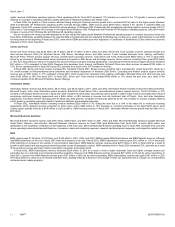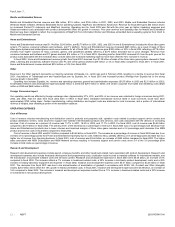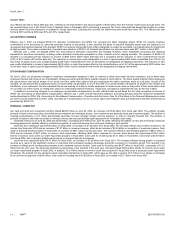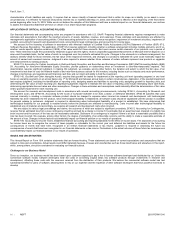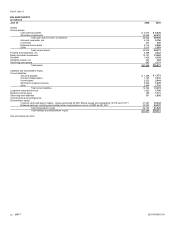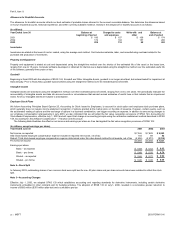Microsoft 2003 Annual Report Download - page 31
Download and view the complete annual report
Please find page 31 of the 2003 Microsoft annual report below. You can navigate through the pages in the report by either clicking on the pages listed below, or by using the keyword search tool below to find specific information within the annual report.Part II, Item 7, 7A
MSFT 2003 FORM 10-K
18 /
and Countervailing Measures. The U.S. government appealed the panel’s decision and lost its appeal. If the ETI provisions are repealed and financially
comparable replacement tax legislation is not enacted, the loss of the ETI tax benefit to us could be significant.
Other Potential Tax Liabilities
We are subject to income taxes in both the United States and numerous foreign jurisdictions. Significant judgment is required in determining our worldwide
provision for income taxes. In the ordinary course of our business, there are many transactions and calculations where the ultimate tax determination is uncertain.
We are regularly under audit by tax authorities. Although we believe our tax estimates are reasonable, the final determination of tax audits and any related litigation
could be materially different than that which is reflected in historical income tax provisions and accruals. Should additional taxes be assessed as a result of an
audit or litigation, a material effect on our income tax provision and net income in the period or periods for which that determination is made could result.
Finite Insurance Programs
In addition to conventional third party insurance arrangements, we have entered into captive insurance arrangements for the purpose of protecting against possible
catastrophic and other risks not covered by traditional insurance markets. As of June 30, 2003, potential coverage available under captive insurance arrangements
was $1.0 billion, subject to deductibles, exclusions, and other restrictions. While we believe these arrangements are an effective way to insure against such risks,
the potential liabilities associated with certain of the issues and uncertainties discussed herein could exceed the coverage provided by such arrangements.
Other
Other issues and uncertainties may include:
warranty and other claims for hardware products such as Xbox;
the effects of the Consent Decree in U.S. v. Microsoft and Final Judgment in State of New York v. Microsoft on the Windows operating system and
server business, including those associated with protocol and other disclosures required by the Decree and Final Judgment and the ability of PC
manufacturers to hide end user access to certain new Windows features;
the continued availability of third party distribution channels for MSN service and other online services;
factors associated with our international operations, as described under International Operations in Part I, Item 1 of this report; and financial market
volatility or other changes affecting the value of our investments, such as the Comcast Corporation securities held by us, that may result in a reduction
in carrying value and recognition of losses including impairment charges.
ITEM 7A. Quantitative and Qualitative Disclosures about Market Risk
We are exposed to foreign currency, interest rate, and fixed income and equity price risks. A portion of these risks is hedged, but fluctuations could impact our
results of operations and financial position. We hedge a portion of anticipated revenue and accounts receivable exposure to foreign currency fluctuations, primarily
with option contracts. We monitor our foreign currency exposures daily to maximize the overall effectiveness of our foreign currency hedge positions. Principal
currencies hedged include the Euro, Japanese yen, British pound, and Canadian dollar. Fixed income securities are subject to interest rate risk. The portfolio is
diversified and structured to minimize credit risk. We routinely use options to hedge a portion of our exposure to interest rate risk in the event of a catastrophic
increase in interest rates. Securities held in our equity and other investments portfolio are subject to price risk, and are generally not hedged. However, we use
options to hedge our price risk on certain highly volatile equity securities that are held primarily for strategic purposes.
We use a value-at-risk (VAR) model to estimate and quantify our market risks. VAR is the expected loss, for a given confidence level, in fair value of our
portfolio due to adverse market movements over a defined time horizon. The VAR model is not intended to represent actual losses in fair value, but is used as a
risk estimation and management tool. The model used for currencies and equities is geometric Brownian motion, which allows incorporation of optionality with
regard to these risk exposures. For interest rate risk, the mean reverting geometric Brownian motion is used to reflect the principle that fixed-income securities
prices revert to maturity value over time.
Value-at-risk is calculated by, first, simulating 10,000 market price paths over 20 days for equities, interest rates and foreign exchange rates, taking into
account historical correlations among the different rates and prices. Each resulting unique set of equities prices, interest rates, and foreign exchange rates is
applied to substantially all individual holdings to re-price each holding. The 250th worst performance (out of 10,000) represents the value-at-risk over 20 days at the
97.5th percentile confidence level. Several risk factors are not captured in the model, including liquidity risk, operational risk, credit risk, and legal risk.
Certain securities in our equity portfolio are held for strategic purposes. We hedge the value of a portion of these securities through the use of derivative
contracts such as put-call collars. In these arrangements, we hedge a security’s market risk below the purchased put strike and forgo most or all of the benefits of
the security’s appreciation above the sold call strike, in exchange for premium received for the sold call. We also hold equity securities for general investment
return purposes. We have incurred material impairment charges related to these securities. The VAR amounts disclosed below are used as a risk management
tool and reflect an estimate of potential reductions in fair value of our portfolio. Losses in fair value over a 20-day holding period can exceed the reported VAR by
significant amounts and can also accumulate over a longer time horizon than the 20-day holding period used in the VAR analysis. VAR amounts are not
necessarily reflective of potential accounting losses, including determinations of other-than-temporary losses in fair value in accordance with U.S. GAAP.
The VAR numbers are shown separately for interest rate, currency, and equity risks. These VAR numbers include the underlying portfolio positions and related
hedges. We use historical data to estimate VAR. Given reliance on historical data, VAR is most effective in estimating risk exposures in markets in which there are
no fundamental changes or shifts in market conditions. An inherent limitation in VAR is that the distribution of past changes in market risk factors may not produce
accurate predictions of future market risk.





